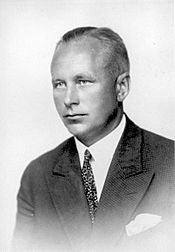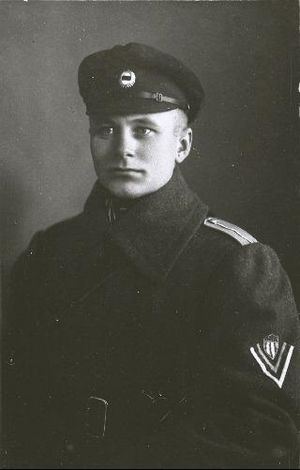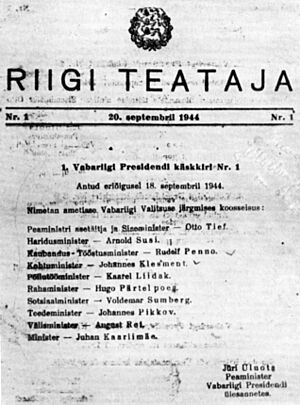Otto Tief facts for kids
Quick facts for kids
Otto Tief
|
|
|---|---|
 |
|
| Born | 14 August 1889 Uusküla, Governorate of Estonia, Russian Empire
|
| Died | 5 March 1976 (aged 86) Ahja, Estonia
|
| Nationality | Estonia |
| Occupation | Lawyer Prime Minister |
Otto Tief (born August 14, 1889 – died March 5, 1976) was an important Estonian politician, a military leader, and a lawyer. He is remembered for his strong dedication to his country.
Tief was the acting prime minister of the last government of Estonia before Soviet troops took over Estonia during World War II in September 1944. Many people in Estonia see him as a symbol of national resistance because he stood up for his country's freedom.
Contents
Otto Tief's Early Life and Career
Otto Tief studied law in St Petersburg from 1910 to 1916. During the Estonian War of Independence, which was a fight for Estonia's freedom, Tief was a commander. He led a group called the Kalevlaste Maleva battalion. This group was formed in 1918 by members of a sports club.
After the war, he finished his law studies at the University of Tartu in 1921. He worked as a lawyer for the Estonian Land Bank and also had his own law practice. Tief was elected to the Estonian parliament, called the Riigikogu, in 1926. He served as the Minister of Social Affairs from 1926 to 1927. In 1928, he became the Minister of Justice. He was elected to the Riigikogu again in 1932.
Otto Tief's Government in 1944
In September 1944, Estonia was going through a very difficult time. The German forces that had occupied Estonia were leaving, and the Soviet Red Army was quickly moving in. During this confusing period, the acting President of Estonia, Jüri Uluots, chose Otto Tief to be the Prime Minister. He asked Tief to form a new government on September 18, 1944.
Tief then made an important announcement. He declared that the independent Republic of Estonia was being brought back, based on its original laws. He also tried to organize the defense of Tallinn, the capital city, against the invading Red Army. However, the Soviet forces entered Tallinn on September 22, 1944.
Here are some of the people who were part of Tief's government:
- Otto Tief – He was the acting Prime Minister and also the Minister of Interior.
- Arnold Susi – He was the Minister of Public Education.
- Johannes Klesment – He was the Minister of Justice.
- Kaarel Liidak – He was the Minister of Agriculture.
- Hugo Pärtelpoeg – He was the Minister of Finance.
- Voldemar Sumberg – He was the Minister of Social Affairs.
- Juhan Pikkov – He was the Minister of Communications.
- August Rei – He was the Minister of Foreign Affairs.
What Happened After 1944?
Otto Tief was arrested by the Soviet authorities on October 10, 1944. In 1945, he was sentenced to ten years in a Gulag, which was a forced labor camp in Siberia.
When he returned to Estonia in 1956, he was not allowed to stay. He was forced to move to Ukraine until 1965. After that, he was allowed to live closer to Estonia, just across the border in Latvia.
Otto Tief passed away on March 5, 1976. The Soviet security services, known as the KGB, would not allow him to be buried in the national cemetery in Tallinn. However, when Estonia became independent again in 1991, his remains were moved and reburied there in 1993. Many people came to honor him at his reburial.
Why Otto Tief is Important to Estonia
Otto Tief's government was in power for only a very short time, from September 18 to September 22, 1944. His efforts to restore independence were quickly stopped by the invading Red Army.
However, Tief's actions have huge meaning for Estonia. When he announced the return of the Republic of Estonia and raised the Estonian flag over the Pikk Hermann tower in Tallinn, it showed that Estonia was still a free country by law. This act helped to prove that the Soviet invasion in September 1944 was not a "liberation" but an occupation.
Even though the attempt to bring back Estonian independence in 1944 didn't succeed right away, the Tief government showed that the Republic of Estonia continued to exist legally. This idea of legal continuity is very important and forms the basis for the independent Estonian state we know today.
Commemoration
In February 2007, the Riigikogu (Estonian parliament) decided to remember the actions of Tief's government. They declared September 22 as the annual "Day of Resistance."
September 22, 1944, was the day when the invading Red Army took over the center of Tallinn. They took down the Estonian national flag and put up the Red Banner, which was a symbol of Soviet occupation. This day reminds Estonians of their struggle for freedom.
See also
 In Spanish: Otto Tief para niños
In Spanish: Otto Tief para niños



